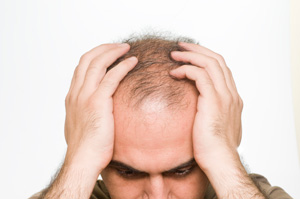
A young man and an older doctor were sitting next to each other at a dinner party when the conversation turned to the subject of male pattern baldness. The man, who had a full head of hair, was arguing that all the money spent on hair replacement remedies and growth agents was wasted. “What is the big deal about hair loss anyway,” he asked.
“Only someone with hair would ask that question,” the balding doctor replied.
To any male experiencing hair loss, this story simply rings true. Most balding patients never believed that hair loss could happen to them because they “had such thick hair!” in their youth. Furthermore, denial is a powerful motivator in this particular medical condition, as anyone witnessing a bad comb-over will tell you. Studies show that the number one reason that men do not treat their hair loss is that they believe, falsely, that it will not get any worse.
Relentlessly Progressive
Unfortunately, this belief that hair loss will suddenly stop at some point is almost completely false. Male Androgenetic Alopecia, commonly known as Pattern Hair Loss, can begin as early as the young teen years and progress until the end of life. It can accelerate and slow randomly, leading to a false sense of security one year, followed by outright panic the next when the balding increases. It is due to the combination of genetics (inherited from either the mother OR the father in what is called an “autosomal dominant” pattern) and the little hormone known as DHT – which is short for DiHydroTestosterone. Together, these two factors will cause a man’s hair to thin slowly over time until the growth is either too weak to provide any cosmetic benefit, or worse, completely absent.
Since there is very little a man can do to change his hair’s genetics (not that gene therapy is not promising, just that it is far from a viable treatment at this point), most of the focus in the medical world has been on early intervention with medications. Propecia (finasteride) and Rogaine (minoxidil) are the two medications with the longest and most successful track records. Differing opinions on these two medications abound – particularly on the Internet – but most doctors will tell you that with regular use the results are predictably good, if not superior. Plus, the earlier a patient starts, the better the results, and ANY hair loss or replacement remedy will take a full year to show improvement due to the rate at which hair cycles. Even surgery takes a full year to grow!
That being said, if you are one of the impatient folk who want their hair back right this very second, you are not alone. As a matter of fact – you are being watched very carefully by many people – particularly on the Internet. Not to make you paranoid, but in particular, beware of the multitude of snake oil selections and home remedies advertised to the uninitiated. Hair is one of those maladies that have a strong emotional component, and the people hawking the latest herbs and spices for your hair know that you will pay to try anything that will give you your hair back. If it sounds too good to be true, realize that it probably is and move on.
Surgery
On the cutting edge.
Of course there are those for whom quick progression of hair loss and a dismal genetic prognosis (i.e. all their relatives have “the horseshoe” left) leaves them knowing that medication alone will not achieve their goals for their hair. Thankfully, technological advances in the past decade or so have made hair restoration surgery not only a viable alternative to medical treatment but an appealing initial step as well. Typically, in today’s hair loss therapy, the permanence of hair grafting is paired with the native-hair-preserving power of medical treatment. In other words; replace what you have lost, but keep what’s left of what you’ve got!
Reputable surgeons who perform this type of surgery are becoming more common, but it can still be tough to find one who specializes in hair surgery so take your time and do your homework. The average surgery can run anywhere between $5,000 and $15,000 for a well-trained surgeon and their highly technical staff. Look also for
- Certification from the American Board of Hair Restoration Surgery (for their optional but rigorous written and oral examination),
- AMA or state medical association membership (for their high ethical standards), and
- International Society of Hair Restoration Surgery affiliation (for their continuing medical education offerings).
Think about the Future
In the final analysis, developing a long-term plan for how you are going to deal with your Androgenetic Alopecia over the years is the best advice. It may not seem like it if you are young with only early hair loss, but you may only care about having hair for part of your life, and most men who suffer from hair loss eventually discover their own happy medium for what looks good on their head and feels right to them. It is an important part of feeling good about one’s self, though, so try not to underestimate its effect on your own psyche and do what it takes to help yourself through this difficult period. Studies show that having a sense of control over our lives makes us happier, so take control of your hair loss and do not let Male Androgenetic Alopecia scare you.
Male Androgenetic Alopecia, commonly known as Male Pattern Hair Loss, can begin as early as the young teen years and progress until the end of life. The balding process can accelerate and slow randomly, and it is due to the combination of genetics and the hormone DHT. Together, these two factors will cause a man’s hair to thin slowly over time until the growth is either too weak to provide any cosmetic benefit, or worse, completely absent.




